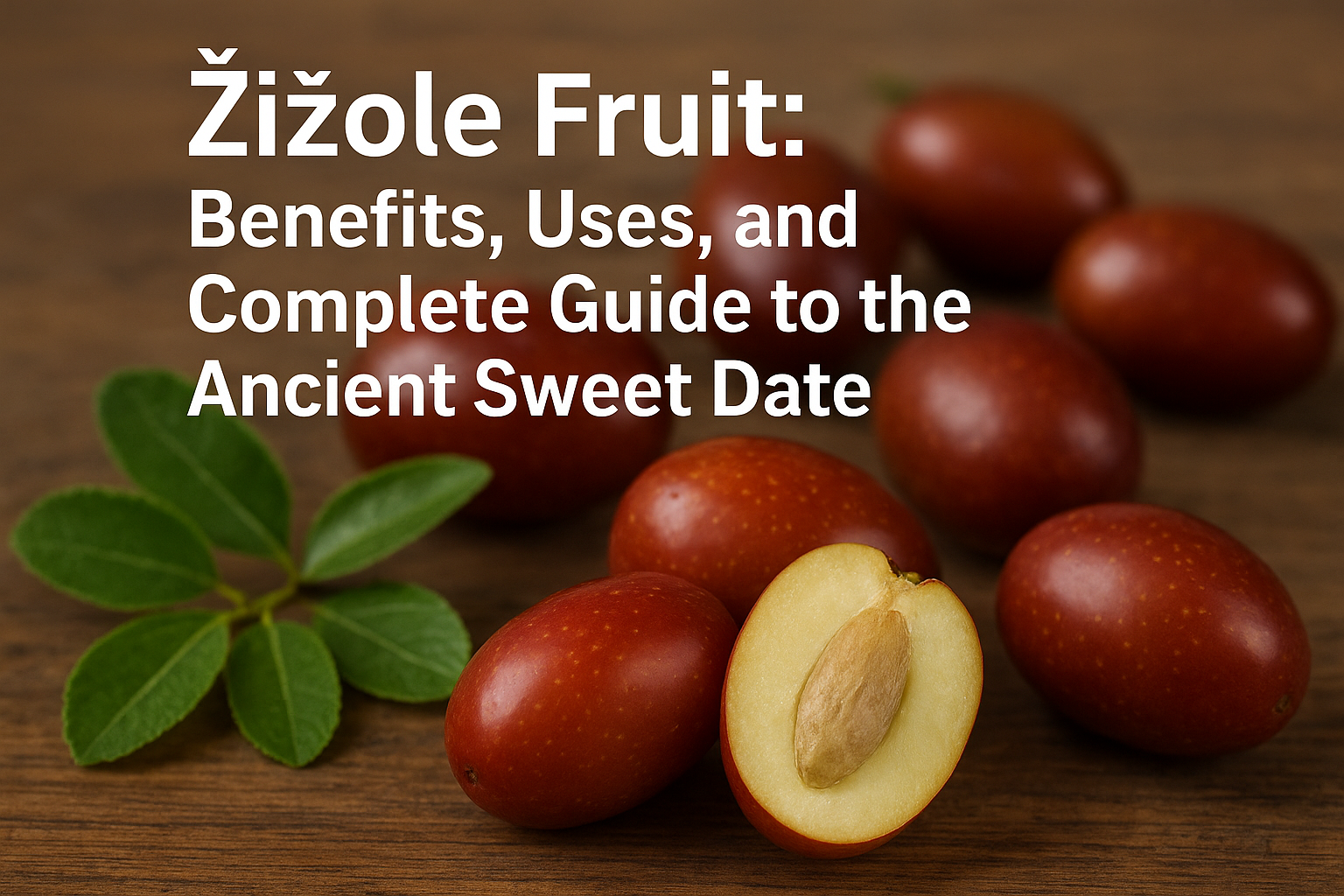Have you ever tasted a fruit that feels like an apple when fresh but turns chewy and sweet like a date when dried? That special fruit is called žižole. People in different parts of the world know it by other names, like jujube or Chinese date, but in many European regions, especially in Dalmatia and the Mediterranean, people lovingly call it žižole.
This article is all about being žižole — what it is, where it comes from, why it matters, and how people use it. By the end, you will know everything important about žižole in a way that is simple and fun to read.
What Is Žižole?
Žižole is a small fruit that grows on a tree called Ziziphus jujuba. The tree can look like a large bush or a small tree. Its leaves are shiny and green, and in the summer it produces small yellow flowers. Later, these flowers turn into little round or oval fruits — the žižole.
When fresh, žižole fruits are green and taste crisp, a bit like an apple. As they ripen, they turn brownish-red. When dried, they wrinkle up and taste sweet, almost like candy. This is why people sometimes call them “red dates.”
The Long History of Žižole
Žižole is not a new fruit. It has been with humans for thousands of years.
- Origin: The fruit comes from China, where it has been grown for more than 4,000 years. It was valued not only as food but also as medicine.
- Travel to Other Lands: Over time, žižole spread across Asia, the Middle East, and into Europe. Traders, travelers, and farmers carried the seeds and planted them in new lands.
- In Europe: In places like Dalmatia, Herzegovina, and parts of the Mediterranean coast, žižole trees became part of local culture. People planted them in gardens and used the fruit to make sweets and drinks.
So, being žižole means being part of a very old story — one that connects Asia, Europe, and the whole world.
How Žižole Looks and Grows
Žižole trees are tough and can grow in many places. They don’t need much water and can handle hot summers. Farmers like them because they don’t require as much care as some other fruit trees.
- Tree Size: Usually between 4 and 10 meters tall.
- Leaves: Small, shiny, and oval-shaped.
- Flowers: Tiny, yellow, and not very showy — but important because they grow into fruit.
- Fruit: Small, round or oval, smooth skin, green when young, brown to red when ripe.
These details make žižole special because not many fruit trees are this strong and adaptable.
Taste and Texture of Žižole
The best part of žižole is, of course, its taste.
- Fresh Fruit: Crunchy like an apple, slightly sweet, sometimes a bit tangy.
- Ripe Fruit: Softer, sweeter, and darker in color.
- Dried Fruit: Wrinkled, chewy, and very sweet, almost like candy or dates.
Children usually love žižole because it feels like eating a natural sweet. Adults enjoy it too because it can be eaten fresh, dried, or cooked.
Why People Value Žižole
Throughout history, people have believed žižole is not just tasty but also good for health. Official reports from food and agriculture studies confirm that žižole has many helpful nutrients.
- Vitamin C: Žižole contains a lot of vitamin C, which helps the body fight sickness and stay strong.
- Antioxidants: These are natural chemicals that protect the body from damage and keep people healthy.
- Fiber: Good for digestion and keeping the stomach happy.
- Minerals: Such as potassium and iron, which help the blood and heart.
In traditional medicine, especially in China, žižole was often used as a natural way to calm the mind, improve sleep, and support the immune system.
So, being žižole means being more than food — it means being a source of strength and wellness.
Žižole in Everyday Life
People enjoy žižole in many ways:
- Fresh Snack: Eaten straight from the tree.
- Dried Fruit: Stored for winter, added to tea, or used in desserts.
- Syrup or Jam: Boiled with sugar to make a sweet spread.
- Žižola Rakija: In some parts of Europe, people make a special fruit brandy using žižole.
- Medicinal Use: Brewed into tea or mixed with herbs for calming effects.
In every case, žižole plays a role in food, health, and tradition.
Cultural Importance of Žižole
In some places, žižole is more than just a fruit. It is part of festivals and family traditions. For example:
- Families gather to pick žižole in the autumn.
- Children look forward to eating them as a seasonal treat.
- Markets and fairs often feature žižole-based sweets and drinks.
This shows that being žižole also means being a part of community life.
Farming and Growing Žižole Today
Even though žižole has been around for thousands of years, it is still important today. Farmers in China, India, Pakistan, the Middle East, and the Mediterranean continue to grow it.
Why? Because it is:
- Easy to grow in poor soil.
- Resistant to drought.
- Valuable as both fresh and dried fruit.
Scientists and agricultural ministries note that žižole is a promising fruit for the future, especially in areas where water is limited.
Myths and Stories About Žižole
Because žižole has been with people for so long, many stories and myths surround it. In traditional cultures, žižole was sometimes thought to bring peace, good sleep, or even protection from evil spirits.
While modern science focuses on vitamins and minerals, these old stories remind us how deeply people valued being žižole in daily life.
Žižole Compared to Other Fruits
Some people ask: “Is žižole like an apple or a date?” The answer is — a little of both.
- Like an apple when fresh: crunchy, juicy, slightly tangy.
- Like a date when dried: chewy, sweet, brown, and long-lasting.
This double nature makes žižole very unique in the fruit world.
The Future of Žižole
With more focus on healthy eating, natural foods, and sustainable farming, žižole is becoming popular again. Researchers suggest that it could help fight food shortages because it grows in tough conditions and provides important nutrition.
That means being žižole today is not only about history and culture but also about helping the world eat better in the future.
Fun Facts About Žižole
- A žižole tree can live for more than 100 years.
- Some call it the “fruit of peace” because of its calming effects.
- The wood of žižole trees is strong and was sometimes used for tools.
- Dried žižole can be stored for months without losing sweetness.
Conclusion
Žižole is more than just a small fruit. It is a part of human history, culture, and health. From ancient China to the sunny coasts of Dalmatia, it has been loved for thousands of years.
Being žižole means being sweet, strong, useful, and timeless. It is a fruit that connects generations, travels across continents, and still finds a place in modern kitchens and farms.
So next time you see a small, round, reddish-brown fruit, remember — you are looking at žižole, a tiny fruit with a very big story.
Read More Team Coaching Course: Unlocking Collective Potential
FAQs About žižole
What does being žižole mean?
Being žižole means more than just being a fruit. It represents sweetness, strength, and history. Žižole is a small fruit that is both crunchy like an apple when fresh and chewy like a date when dried, making it special and unique.
Where does žižole come from?
Žižole originally comes from China, where it has been grown for over 4,000 years. Over time, it spread to the Middle East, Europe, and the Mediterranean, becoming part of local food traditions and culture.
Why do people eat žižole?
People eat žižole because it is tasty and healthy. It has vitamin C, fiber, and antioxidants that help the body stay strong. It can be eaten fresh, dried, or made into jam, tea, or even drinks.
Is žižole the same as a date or an apple?
Žižole is not the same, but it has qualities of both. When fresh, it feels like a crunchy apple. When dried, it becomes sweet and chewy, like a date. That is why some people call it a “red date” or “Chinese date.”
How do people use žižole in daily life?
Žižole is used in many ways: eaten as a snack, dried for storage, made into jams and syrups, or brewed in tea. In some regions, it is even turned into a fruit brandy. Families also see it as part of tradition, picking and sharing žižole during harvest time.
Another Topic To Read Why Choosing the Right Life Insurance Provider in the USA Matters?


